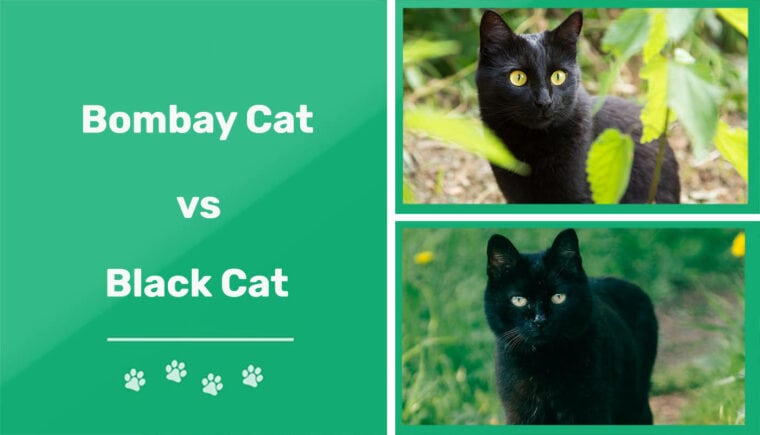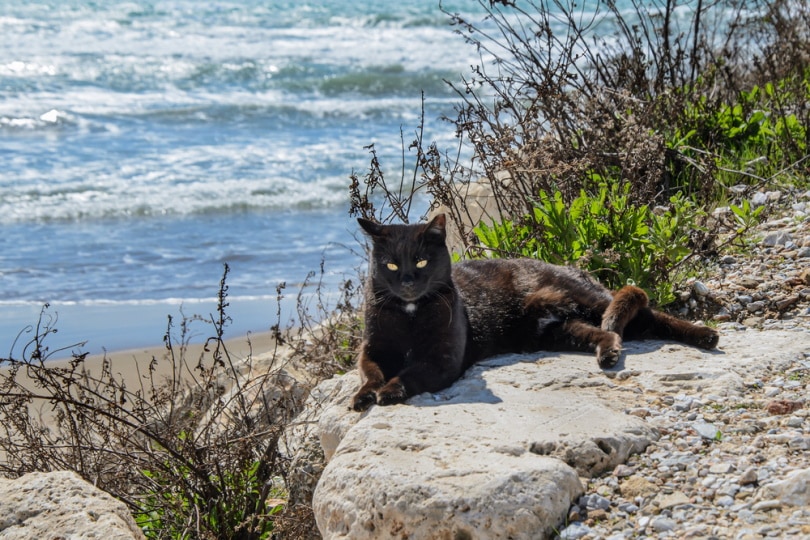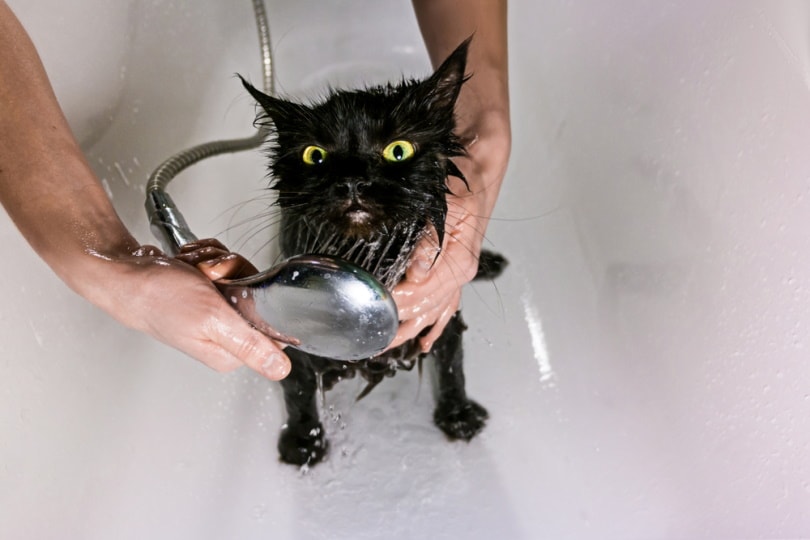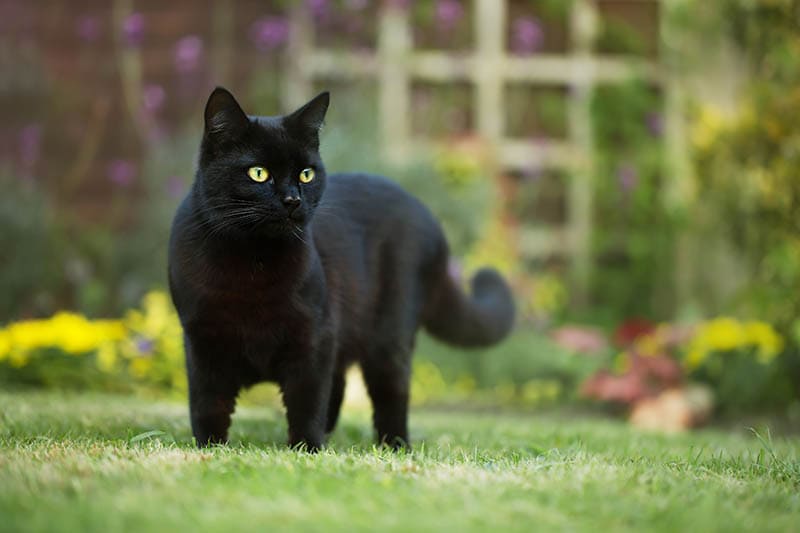
Click to Skip Ahead
Although it might be difficult to tell them apart at first glance, Bombay cats and black cats have quite a few differences. Bombays, for example, are a specific crossbreed with a unique lineage, whereas black cats are not a specific breed but only a specific color.
In other words, many breeds can be black cats, but only a Burmese cat crossed with an American Shorthair cat can be a Bombay. The detailed information below will help you discover the differences and determine if your feline friend is a black cat or a relatively rare Bombay cat.
Visual Differences

At a Glance
(NOTE: The numbers and data above are based on the average black cat.)
Bombay Cats Overview

As mentioned, the Bombay cat is a crossbreed of the Burmese and American Shorthair. This cross was first seen during the 1950s in the United States to create a cat that looked like a Black Leopard. Most will agree that the breeders were quite successful.
Personality / Character
Bombay cats are curious, active, and highly adaptable. They’re typically spirited and affectionate and are wonderful lap cats (often to the chagrin of their humans). Bombays like being picked up more than most breeds, at least when they’re young.
One thing most Bombay owners have noted, however, is that as they get older, they become observers rather than participants in activities around their homes. Bombay cats do well in multi-cat homes. If you work outside your home, having another cat as a playmate for your Bombay is a good idea since they are above average on the social scale.
Exercise
As with most cats, Bombays are active at times and sedentary at other times, and there’s no real rhyme or reason to their activity. Veterinarians recommend spending 10 to 20-minute periods playing and engaging with your Bombay several times daily.
You must provide plenty of cat toys to keep them busy and mentally stimulated. A cat tree is a must, as well as cat shelves and other places to climb on, sit in, and gaze down upon their domain. They love relaxing in catios and closely watching the wildlife outside.

Training
You might be surprised how many things you can train your Bombay cat to do, including playing “fetch!” Like most cats, you’ll need a lot of time and patience to train a Bombay cat, but most will respond to training well and learn quickly compared to other breeds. Compared to other breeds, Bombay cats are more eager to please their owners, at least when they’re young.
Positive reinforcement is the best method for training your Bombay cat. After all, they’re sensitive creatures and don’t take kindly to being scolded. If you put in the time, you’ll find that your Bombay can be trained to walk on a leash and ride around with you in a backpack, among other fun activities.
Health & Care
Bombay cats are one of the healthier breeds with few genetic predispositions to illnesses or health issues. The biggest problem we found in our research was obesity, which usually occurs during a Bombay cat’s senior years. Obesity, if left unchecked, can lead to heart disease, diabetes, and cancer, so you must feed your Bombay a healthy diet and ensure they get just enough food but not too much.
Grooming
With such a lovely coat, you might assume that your Bombay cat will need daily grooming, but the opposite is true. Bombays are low-maintenance felines that shed very little most of the year and don’t need a lot of brushing to look great; once a week will likely be plenty.
Your Bombay’s eyes might need to be cleaned of goop occasionally, and a quick check of their ears is also a good idea. Clipping their nails when needed is a must, as well as weekly tooth brushing.

Suitable For:
Bombay cats are affectionate, adaptable cats that do well in almost any situation. They’re ideal for active families with children as long as the kids are shown how to handle their cats properly.
A Bombay can thrive in a big home or small apartment, but as a social cat, it’s a good idea to provide them a feline playmate. Adopting two Bombays, if it’s financially feasible, is a great idea, but they will get along with just about any other breed, including a black cat!
Black Cats Overview

Unlike Bombay cats, Black cats are a color, not a specific breed. Twenty-two breeds of cats can have a black coat (at last count), which means your black cat could have various breeds in their genes. This makes it rather difficult to give specific information about “black cats” because they can be so many breeds. The data below is thus based on the “average” black cat.
Personality / Character
The average black cat is outgoing, and friendly but somewhat aloof. They might want your attention one minute and completely ignore you or even get angry with you the next. Some black cats are shy, while others are outgoing and affectionate. One way to ensure your black cat is the latter is to socialize them as kittens, handling them often and getting them used to being around you, your family, and your other pets.
Exercise
Your black cat will need cat toys to play with and as much of your time as you can set aside to play with them. Cat trees, boxes, cat shelves, and a catio are all recommended no matter the breed of your black cat, but some breeds will like specific toys more than others.
Veterinarians recommend playing with your black cat in short bursts, which will hold their attention and keep them entertained. Doing this several times a day rather than all at once is ideal to keep them engaged.
Training
The breed of your black cat will be the most significant factor as to whether you can train them to do tricks and commands. Some black cat breeds are easier to train than others, and some don’t take to training very much at all. On average, however, training black cats to use a litter box is relatively easy.
No matter the breed of black cat you adopt, it’s worth giving training a shot. It’s important to remember that, even if you can’t train them, most black cats will learn things as they age and may surprise you with the skills they acquire and the commands they listen to.

Health & Care
Since we’re basing this information on the “average” black cat, we will list the 10 most common health issues that affect cats. Your cat might be prone to one or several of the following issues, or they might not, depending on the breed, age, and other factors.
Grooming
The average black cat will need grooming, including being brushed occasionally. Longhaired black cats must be brushed more often than shorthaired ones; daily brushing is required for most longhaired breeds, but twice a week is enough for shorthaired kitties. Nail clipping, tooth brushing, and regularly checking your cat’s eyes and ears are vital for keeping them healthy. Depending on your cat’s coat, an occasional trip to a professional groomer might also be warranted.

Suitable For:
The breed of your black cat will be the main factor determining who they are suited for. However, as mentioned earlier, if you socialize your cat as a kitten and introduce them to people, pets, places, and circumstances, they will be suited to many situations and families.
Black cats, as a whole, are highly adaptable animals and will do fine in most loving homes. They need daily exercise, a few play sessions with their owners, and a well-balanced diet to thrive.
How to Tell the Difference Between a Bombay Cat and a Black Cat
Since black cats can be many breeds and Bombay cats are a specific cross between a Burmese and American shorthair cat, there are some easily recognizable visible differences between them.
Their Coat
One of the biggest differences (and most difficult to see) between Bombay cats and black cats is that Bombays will always have a short coat that looks surprisingly similar to velvet and is silky smooth. Your typical black cat can have long or short black hair, and if they go out in the sun for any length of time, their coat can change colors, revealing their tabby roots. A Bombay’s coat will always stay jet black.
Eye Color and Size
All Bombay cats have gold or copper-colored eyes. Also, Bombay cats have significantly larger, rounder eyes than the average black cat. Their big, round eyes are one of the easiest ways to determine if your cat is a Bombay or a cat with black fur. Black cats can have all varieties of eye colors and have eyes shaped like almonds.
Black Noses and Paw Pads
While black cats can have several colors of paw pads and noses (pink, gray, brick, or black), Bombay cats will always have black noses and black paw pads. Also, a Bombay’s nose is more compact and shorter than the average black cat, like a panther.
Compact, Muscular, Well-proportioned Bodies
Like the large cat they were created to resemble, the panther, a Bombay cat’s body will be compact and muscular. The average black cat will have a longer, leaner body.
Ear Shape
The ears of a black cat can be one of many shapes depending on their particular breed and genetics. On the other hand, Bombay cats have wide-set ears that are always upright and rounded at the tips.
Which Breed Is Right for You?
Bombay cats are a unique and beautiful crossbreed that appeal to cat fans because of their beautiful back coats and round, golden-colored eyes. They’re energetic felines that love spending time with their families, but because they’re not very common, they cost more to adopt than a standard black cat. The average black cat will make just as good a companion as the Bombay and become just as big a part of your family.
If you love the way the Bombay cat looks and have the financial ability, by all means, adopt one and make them a part of your life. If you’re on a budget but still want an affectionate cat to call your own, a black cat is an excellent choice!
Featured Image Credit: (T) Viktor Sergeevich, Shutterstock | (B) Daria Shatova, Unsplash





